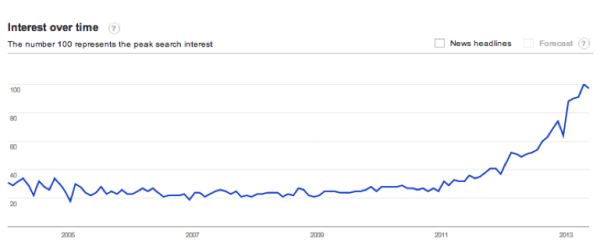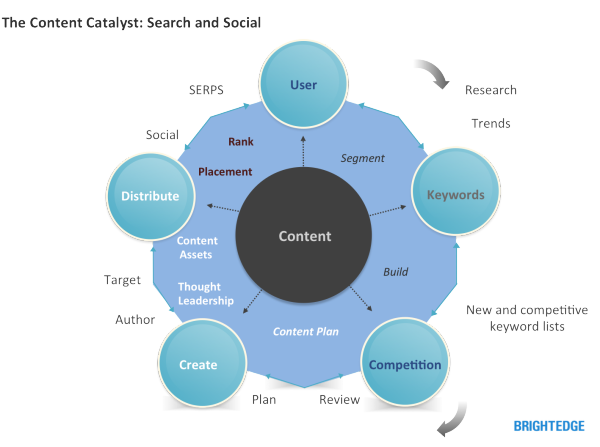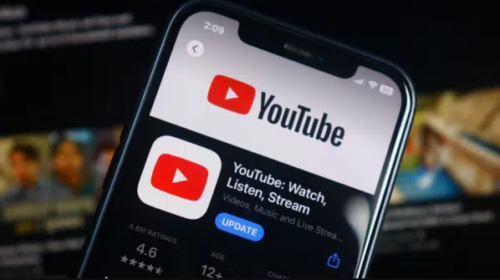The Content Catalyst: How Content Drives Search & Social Synergy
Today, many a search marketer lives in a world driven by Pandas and Penguins. SEO as we used to know it has changed forever. As Google shifts its focus to quality and relevancy, content marketing adoption has soared. It is no coincidence that the increasing focus on content marketing closely follows the significant Google algorithmic […]
As Google shifts its focus to quality and relevancy, content marketing adoption has soared. It is no coincidence that the increasing focus on content marketing closely follows the significant Google algorithmic changes aiming to give users a better search experience.

Google Trends chart for the key phrase [Content Marketing] — interest has taken off since February 2011, when the Panda update was rolled out.
Traditional black hat tactics aimed at gaming the Google algorithm are being replaced by creative, quality content marketing campaigns that fuel both search and social media activities. Content marketing has become a valuable tool to bridge the gap between the two, fostering communication and teamwork across multiple channels and departments within an organization.In a previous post, I discussed how search and social are becoming more and more closely aligned. If you listen to industry leaders on this topic, you will hear statements like “social is the new search,” “search and social are one,” and “you cannot manage search and social in silos.” Content marketing is indeed the glue that binds the search and social media relationship.
Content & The Search & Social Relationship
The search and social graphs have made giant strides in the recent past, and parallels can be drawn between these developments. Marketers are now faced with a complex and large search and social ecosystem that offers a world of opportunity for content-driven SEO marketers.
The relationship between social and search has changed, and several forces are behind this transformation. Content is now consumed and distributed locally and globally, across multiple devices (PC, mobile, tablet) and in multiple formats (text, video, images, etc.). It has become easier than ever for nearly anyone to create, share and consume content, leading to an overwhelming abundance of content on the Web.
As a result, social engagement is becoming increasingly dependent on high quality content, and search engines have begun to take social signals into account as a quality indicator, simply as a means of wading through the massive amounts of content out there. It is essential that marketers dig deeper into search, social, local and mobile data to understand how they all work in tandem to impact rankings.
The Changing SERP & Content
Since August, Google has been serving (for some keywords) SERPs with 7 organic listings, instead of the usual 10 listings. In many cases, these organic listings have been supplanted by things like image results and local results with maps, etc. In 2013, as Google rewards quality and relevancy, there are many opportunities to rank across multiple search types and in multiple formats to dominate the new Google SERP results across image, video, places, news and social media results.
If you look further into the way the SERPs have changed recently, video, social, mobile and local rankings all require good creative and different types of content to fuel them. Technical SEO is important, but will only get you so far — your SEO efforts need the catalyst that is content marketing.
Content & SEO – A Synergetic Relationship
Content marketing provides search and social media marketers with a new opportunity to impact SEO, improve search rankings, and increase revenue generated through organic search. Focusing on social media activity to uncover SEO opportunities, and then offering actionable recommendations to increase visibility on search engines, is becoming a key priority for search marketers.
Content related to social engagement is the type of content that marketers are prioritizing in 2013. Seventy-eight percent (78%) of the marketers surveyed in the BrightEdge Search Marketers Survey stated that they would be focusing more on this in 2013.

Using Content To Drive Your Online Marketing Efforts
Below is a framework to ensure that content is driving your search and social efforts. This process builds upon search and social content synergies — not only does content drive your search and social activities, but your search and social research helps inform you to build your content plan.

The User
Understanding the user is paramount to leveraging content as your search and social catalyst. Optimizing for your target audience and for consumers is just as important as optimizing your keywords — a fact sometimes overlooked by search marketers.
Keywords – You & The Competition
Once you understand the users you are targeting, you can begin to look at a combination of keywords and social trends. Look at your baseline rankings and compare them against those of your competitors in the SERPs. What does their content look like? What content strategies are working for them? Use this to start brainstorming your own content, around which your search and social strategies will be built.
Social Trends & Topics
The relationship between search and social referrals is growing — understanding the correlation between social sharing and search rankings is essential as marketers use content marketing insights to further integrate social media and SEO strategies.
Monitor social media for topics relevant to your search keywords. Analyze the content being shared to reinforce what’s working while phasing out what isn’t.
Taking the correlation between search and social into account has proven to work. TinyPrints saw a 47% increase in rankings by integrating its organic search and Twitter strategies based on a clear understanding of this correlation.
Content Creation
 Of course, the content you create has to be unique, insightful and relevant — Google set up Author Rank to encourage content creators and bloggers to publish precisely such content, as (presumably) nobody wants spammy or low-quality content attached to their name.
Of course, the content you create has to be unique, insightful and relevant — Google set up Author Rank to encourage content creators and bloggers to publish precisely such content, as (presumably) nobody wants spammy or low-quality content attached to their name.
But when it comes to content, SEO marketers face challenges not just in terms of quality, but also methodology and management — especially in cases where the content and SEO teams have not historically worked close together.
Integrating your content creation process and your SEO process promotes learning across content and the SEO teams. It also provides scale and efficiency — users can create and optimize in sync without having to switch from SEO tools to CMS systems. The result is great content that is SEO friendly and allows you to maximize results from search (rankings, traffic, conversions, and revenue).
Travelocity made SEO an integral part of the content authoring process through Adobe Experience Manager with outstanding results. BrightEdge research revealed that for large sites, eliminating just two of the types of SEO errors found in the Travelocity study was associated with a 10% traffic increase and a five position hike in organic search rank.
Content Formats & Distribution
Producing quality content that aligns with your larger keyword strategy involves creating and repurposing content in multiple formats that ultimately fuel your SERP position strategy. Before I list a few types of content assets for distribution, it is important to remember the SEO basics such as:
- Optimizing title tags for each piece of your content
- Ensuring your copy is keyword focused but not “over” optimized
- Ensuring you optimize any inbound links from related content
You can then look at producing and distributing content across multiple channels and formats for search and social success based on a “build and share” methodology.
- Optimized webpages full of rich and unique content
- Guest posts
- Syndication projects
- Integrated SEO and PR projects
- Presentations
- Research projects
- Market insights
- Quality white-papers
- Case studies
- Client video testimonials
Conclusion
Taking a planned, detailed, and holistic approach to content across all digital media channels is very important to SEO success in 2013. Producing, managing, and sharing content is going to be a key priority for search marketers.
The wins from content marketing are long term compared to traditional SEO short-term, quick win tactics. The more unique and insightful content you produce, the more likely you are to rank/position in the long term.
Content is the catalyst that drives search and social media activity.





